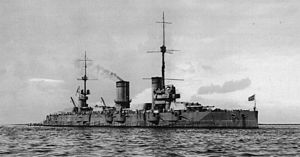Russian battleship Gangut (1911)
 Gangut at anchor in Helsinki, Finland, 1915
| |
| History | |
|---|---|
| Name | Gangut |
| Namesake | Battle of Gangut |
| Builder | Admiralty Works, Saint Petersburg |
| Laid down | 16 June 1909[Note 1] |
| Launched | 20 October 1911 |
| Commissioned | 11 January 1915 |
| Name | Oktyabrskaya Revolutsiya |
| Namesake | October Revolution |
| Acquired | November 1917 |
| Renamed | 27 June 1925 |
| Reclassified | 24 July 1954 |
| Stricken | 17 February 1956 |
| Nickname(s) | Oktyabrina |
| Honors and awards | Order of the Red Banner 22 July 1944 |
| General characteristics (as built) | |
| Class and type | Gangut-class battleship |
| Displacement | 24,800 tonnes (24,400 long tons; 27,300 short tons) |
| Length | 181.2 m (594 ft) |
| Beam | 26.9 m (88 ft) |
| Draft | 8.99 m (29.5 ft) |
| Propulsion |
|
| Speed | 24.1 knots (44.6 km/h; 27.7 mph) (on trials) |
| Range | 3,200 nautical miles (5,900 km; 3,700 mi) at 10 knots (19 km/h; 12 mph) |
| Complement | 1,149 |
| Armament |
|
| Armor |
|
Gangut (Russian: Гангут) was both the lead ship of the Gangut-class dreadnoughts of the Imperial Russian Navy built before World War I and the last of her class to be completed. She was named after the Russian victory over the Swedish Navy in the Battle of Gangut in 1714. She was completed during the winter of 1914–1915, but was not ready for combat until mid-1915. Her role was to defend the mouth of the Gulf of Finland against the Germans, who never tried to enter, so she spent her time training and providing cover for minelaying operations. Her crew joined the general mutiny of the Baltic Fleet after the February Revolution and joined the Bolsheviks in 1918. She was laid up in 1918 for lack of manpower and not recommissioned until 1925, by which time she had been renamed Oktyabrskaya Revolutsiya (Russian: Октябрьская революция: October Revolution).
She was reconstructed between 1931 and 1934 with new
Design and description

Gangut was 180 meters (590 ft)
Gangut's machinery was built by the Franco-Russian Works. Four

The main armament of the Ganguts consisted of a dozen 52-
Service
Gangut was built by the

Gangut was
She finished her reconstruction on 4 August 1934.[8] Her participation in the Winter War was limited to a bombardment of Finnish 10-inch (254 mm) coast defense guns on 18 December 1939 at Saarenpää in the Beryozovye Islands before the Gulf of Finland iced over. She failed to inflict any permanent damage before she was driven off by near misses.[12] Oktyabrskaya Revolutsiya sailed to Tallinn shortly after the Soviets occupied Estonia, but she was refitted in February–March 1941 in Kronstadt and her anti-aircraft armament was reinforced. Two twin-gun 76.2 mm (3 in) 81-K mounts were mounted on her quarterdeck. The magazines for these guns were probably situated in the rearmost casemates on each beam, which lost their 120-mm guns and twelve automatic 37-millimeter (1.5 in) 70-K guns were also added, three guns each on the middle turrets and the other six in the fore and aft superstructures. Four twin and four single 12.7-millimeter (0.50 in) DShK machine guns and two AA directors were also fitted. The large cranes were replaced by smaller ones taken from the ex-German heavy cruiser Petropavlovsk to make room for the anti-aircraft guns.[13]

On 22 June 1941 Oktyabrskaya Revolutsiya was in
She was reclassified as a 'school battleship' on 24 July 1954 and stricken on 17 February 1956. She was slowly scrapped and her hulk still survived in May 1958.[8]
Notes
Footnotes
- ^ McLaughlin, p. 207
- ^ McLaughlin, pp. 208, 224–225
- ^ a b McLaughlin, pp. 220–221
- ^ Budzbon, p. 303
- ^ Цветков, И.Ф. Линкор Октябрьская Революция (in Russian). Leningrad: Ленинград "Судостроение". p. 107.
- ^ McLaughlin, p. 299
- ^ McLaughlin, pp. 207, 299–303
- ^ a b c McLaughlin, p. 225
- ^ McLaughlin, pp. 342–44
- ISBN 978-1-59114-555-4.
- ^ McLaughlin, pp. 341, 344
- ^ McLaughlin, p. 401
- ^ a b McLaughlin, p. 406
- ^ Rohwer, p. 98
- ^ a b McLaughlin, pp. 402, 406
- ^ Rohwer, p. 157
Bibliography
- Budzbon, Przemysław (1985). "Russia". In Gray, Randal (ed.). Conway's All the World's Fighting Ships 1906–1921. Annapolis, Maryland: Naval Institute Press. pp. 291–325. ISBN 0-85177-245-5.
- Budzbon, Przemysław (1980). "Soviet Union". In Chesneau, Roger (ed.). Conway's All the World's Fighting Ships 1922–1946. Greenwich, UK: Conway Maritime Press. pp. 318–346. ISBN 0-85177-146-7.
- Budzbon, Przemysław; Radziemski, Jan & Twardowski, Marek (2022). Warships of the Soviet Fleets 1939–1945. Vol. I: Major Combatants. Annapolis, Maryland: Naval Institute Press. ISBN 978-1-68247-877-6.
- McLaughlin, Stephen (2003). Russian & Soviet Battleships. Annapolis, Maryland: Naval Institute Press. ISBN 1-55750-481-4.
- ISBN 1-59114-119-2.
External links
- Specifications
- Short article plus photo gallery (in Russian)
- A detailed account of the 1915 mutiny on Gangut (in Russian)
